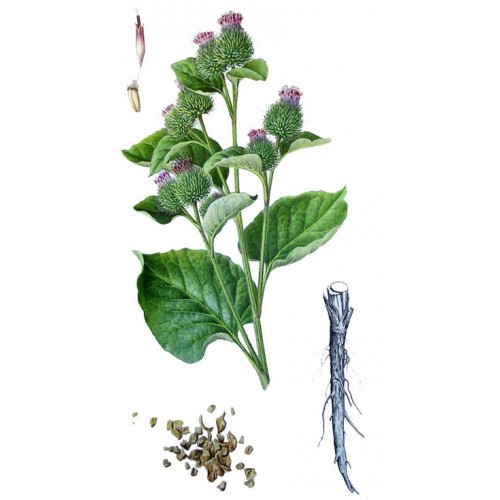ROOTIN’ DOWN
Burdock has been used by many cultures throughout history for its ability to help detoxify the body and root out health issues. It was listed in the United States Pharmacopeia from 1831 to 1916, and the National Formulary from 1916 to 1947.
Did you know your tummy is a battleground between good and bad bacteria?! It is, and Burdock’s main action is to feed the good bacteria with a fiber known as inulin, so they can grow big (but still microscopic) and strong and beat up the bad bacteria. While inulin is actually indigestible to humans, those healthy bacteria find it oh so delicious!
The root is also used for all manner of pesky skin conditions, including eczema, psoriasis, and acne.
It can be a blood purifier and detoxification herb and is a key component in many old and famous herbal formulas used for treating cancer throughout history. Plus, it’s quite gentle, which means it can be taken for long periods of time in large amounts with relatively little worry.
As spring approaches, you will naturally gravitate towards clearing out your body for a fresh start, and burdock is the perfect herb to add to your daily routine to help facilitate the cleansing process.
MATERIA MEDICA: BURDOCK
Common Names: Burdock root
Latin Name: Arctium lappa
Botanical Description:
Burdock is a biennial, and in the first year, grows as a rosette close to the ground. The lower leaves are large, often a foot long with gray fine short hairs on the underside. The upper leaves are smaller with a bit less down. The second-year plant can grow as high as 9 feet tall. The clustered flowers are purple and in capitula, which are covered in hooked bracts that catch on animal fur and clothing. The root can grow as deep as three feet.
Key Constituents: Tannin, arctigenin, arctiin, beta-eudesmol, caffeic acid, chlorogenic acid, inulin, trachelogenin 4, sitosterol-beta-D-glucopyranoside, lappaol, diarctigenin, minerals, vitamins B1, B2, C, and A, carotene, polysaccharides (inulin), flavonoids, lignans, mucilage, pectin, (Chan et al., 2011; Hoffman, 2003; Chevallier, 2000).
Parts Used: root harvested just after the first year root has finished growing (biennial)
Harvesting Guidelines:
Burdock root accumulates toxins and pollutants so be sure to harvest at least 50 feet from roads and away from roof drip lines, areas where chemicals are sprayed, and well away from industrial areas.
Burdock is a biennial, meaning it takes two years to grow. The first year is spent gathering energy and nutrients from the earth into the roots. The second year, the energy and nutrients are sent up to the above-ground part of the plant to make seeds.
Thus, for the best, most nutritious roots, harvest first year plants in the fall. First-year plants won’t have a seed stalk. Burdock root may also be dug up in the spring of the second year before the seed stalk has come up. Digging burdock takes patience. Loosen the dirt around the taproot with a stick, and slowly work the root free with your fingers. If you pull too hard, the root will snap. With persistence, roots can be harvested two feet or more in length.
Leaves can be harvested in late summer of second-year plants.
Seeds can be harvested in fall of second-year plants. To harvest the seeds, use both a thick pair of gloves and garden shears. Pick the burrs off the plant (or off your shirt) and place inside a paper bag. Close the bag and shake and massage it vigorously to dislodge the seeds from the burrs. (The Herbarium)
Preparation & Dosing:
- Tea simmer the root for 20 min then drink with the root still in the cup, 3-4 oz 2-3 times a day,
- Cold infusion ½ to 1 cup drunk twice a day for two weeks for skin conditions
- Tincture: 2 – 4 mL of a 1:5 in 40%, three times a day
- Food burdock is excellent when added to soups and stews. Sometimes you can buy the fresh root at natural food stores.
Energetics & Taste: Neutral to dry, cool, sweet, slightly bitter
Parts Affected: skin and surfaces of the body, intestines
Actions:
- detoxifying
- nutritive
- alterative
- bitter tonic
- lymphatic
- diuretic
Primary Uses:
- The inulin in burdock feeds the lactobacilli bacteria that live in your intestines, which is a good thing. These healthy bacteria help to keep the bad ones in check. For this reason, burdock is considered to be a pre-biotic. The inulin is only present in the tea when boiled for a long time (or when the root is eaten)
- Used as a detoxifying herb
- Good for detoxifying the skin for conditions such as acne, eczema, psoriasis, and others
- Improves the digestion
- Increases the movement of the lymph and increases the movement of the blood towards the capillaries
Cautions: may cause allergic reactions to those sensitive to Asteraceae plants
Browse by category
- Aromatherapy
- Astrology & Magic
- Ayurdeva
- Botany Foraging & Gardening
- Chakras
- Digestion
- Earth Connection
- Energetics
- Flower & Gem Essences
- Folk Traditions
- Herbalism & Holistic Health
- Immune Support
- Materia Medica
- Mushrooms
- Nutrition
- Seasonal Living: Autumn
- Seasonal Living: Moon
- Seasonal Living: Spring
- Seasonal Living: Summer
- Seasonal Living: Winter
- Skin & Body Care

Don’t Miss a Thing!
Enter your email below to be the first to know about sales, new products and tips for taking care of your pieces.



